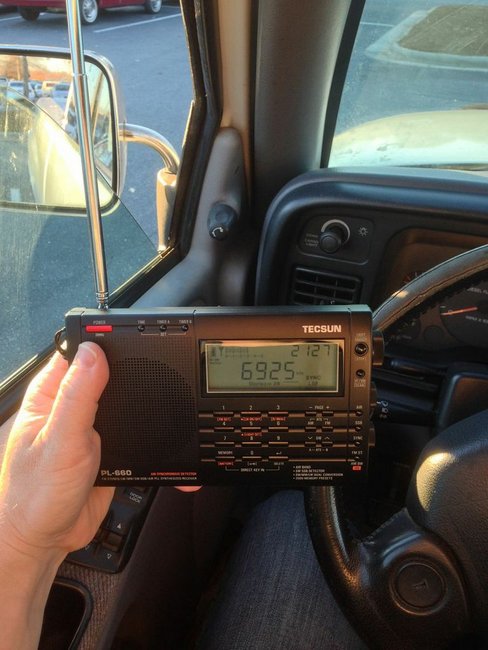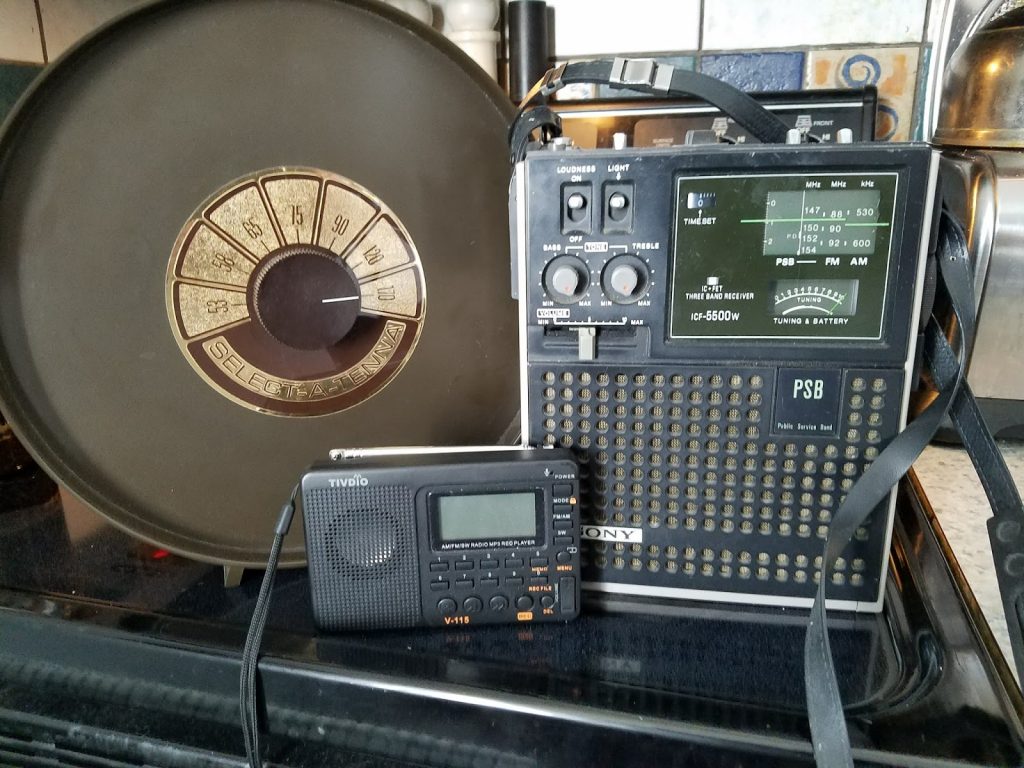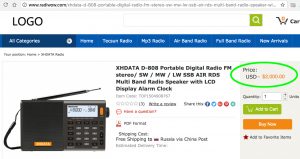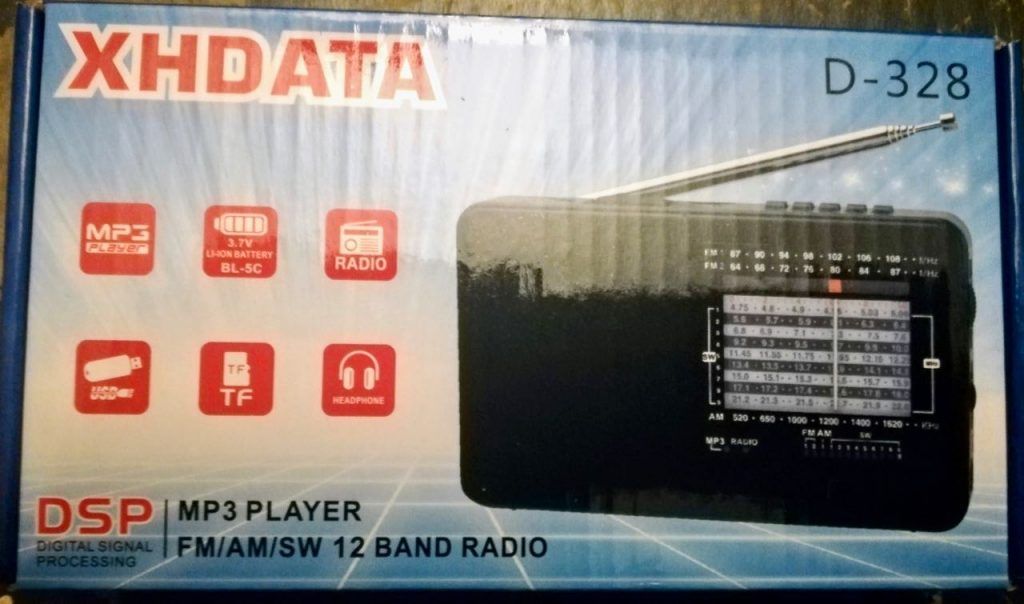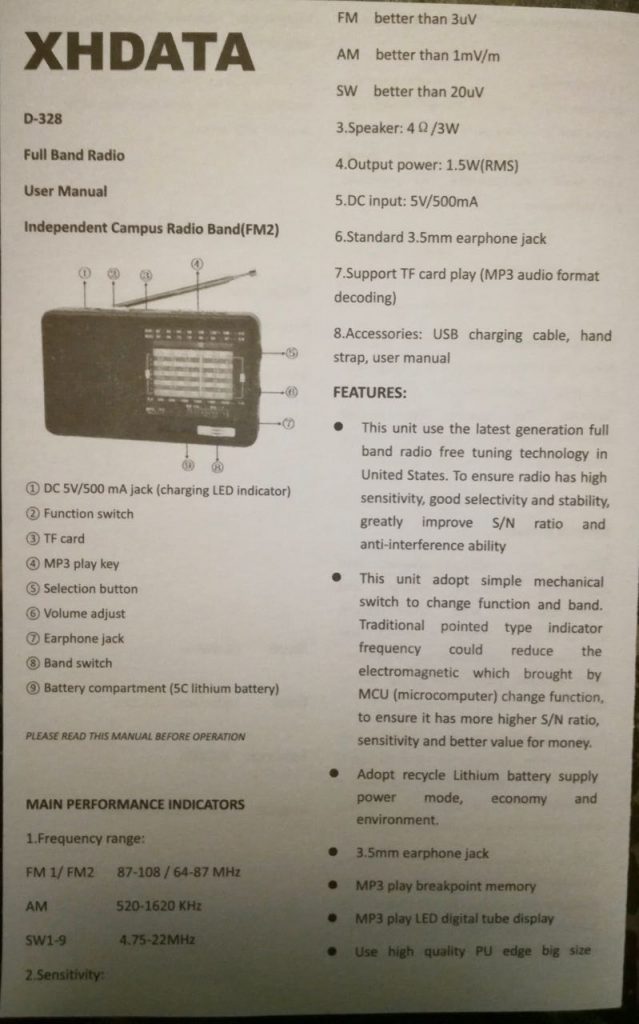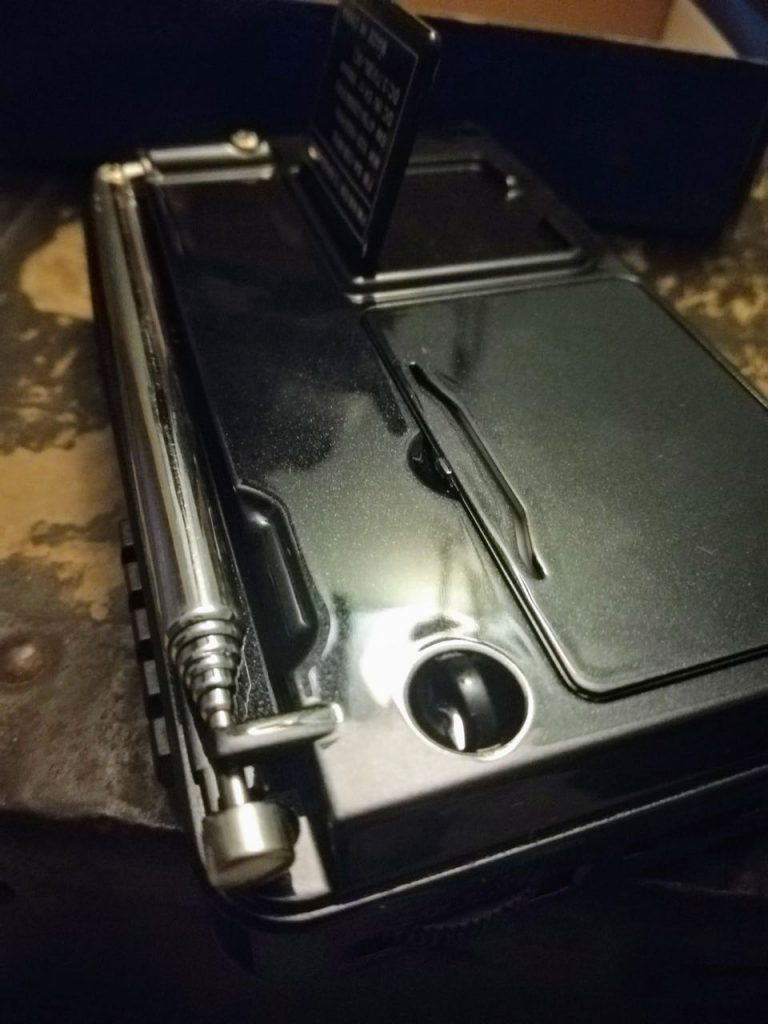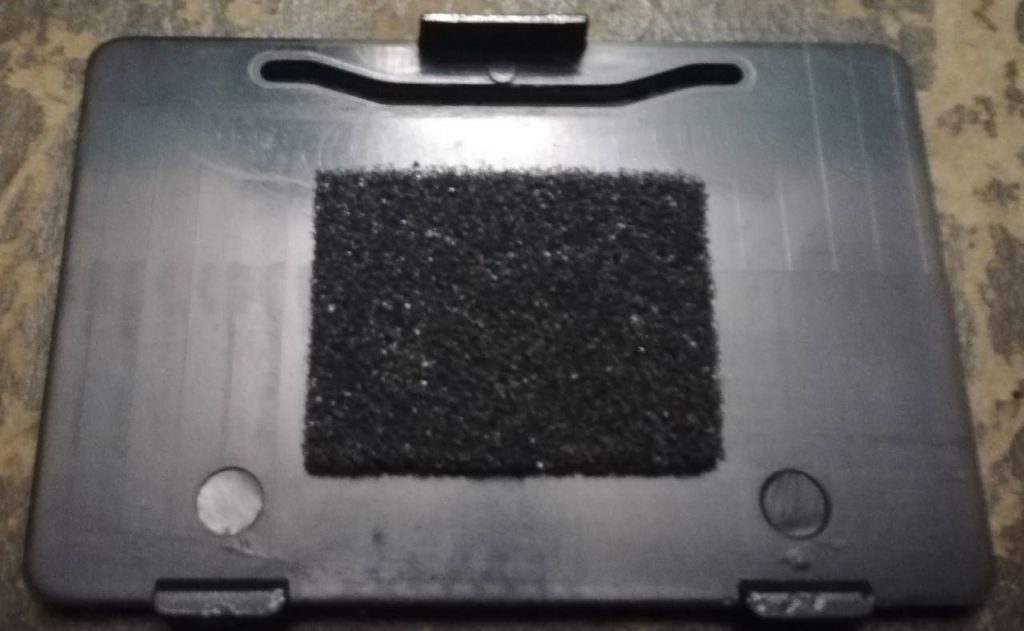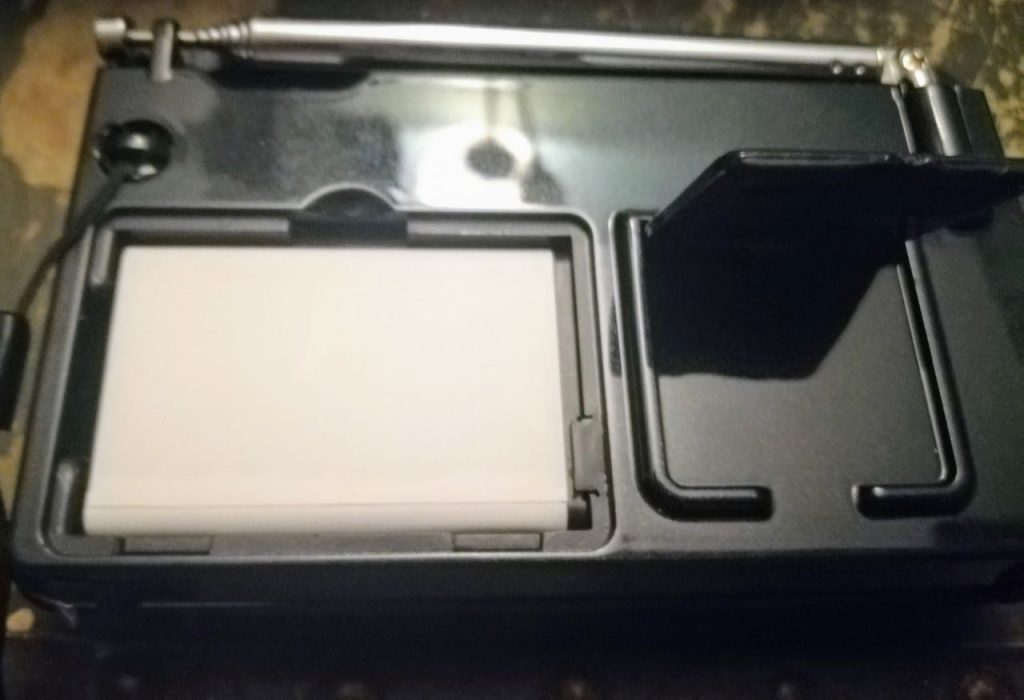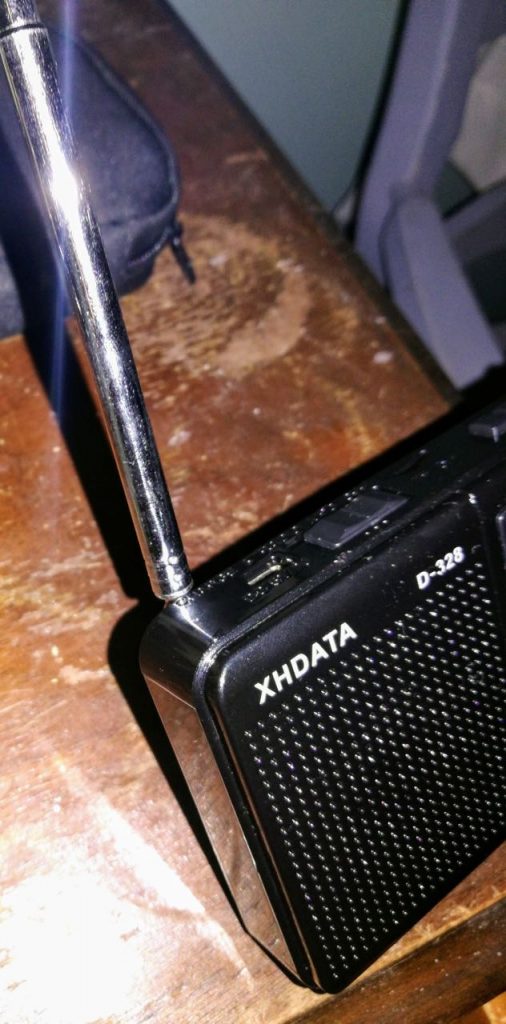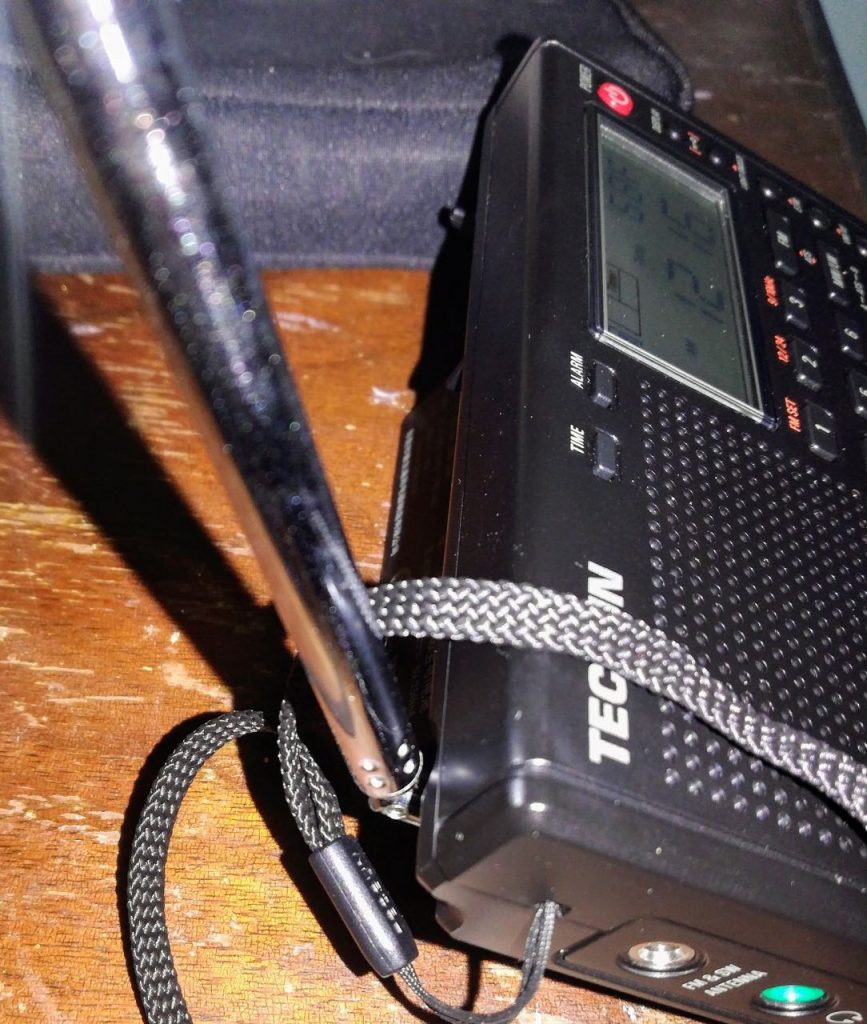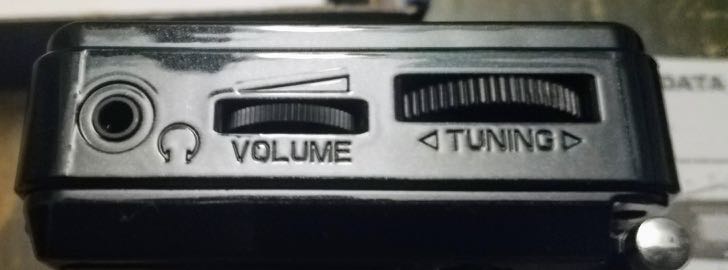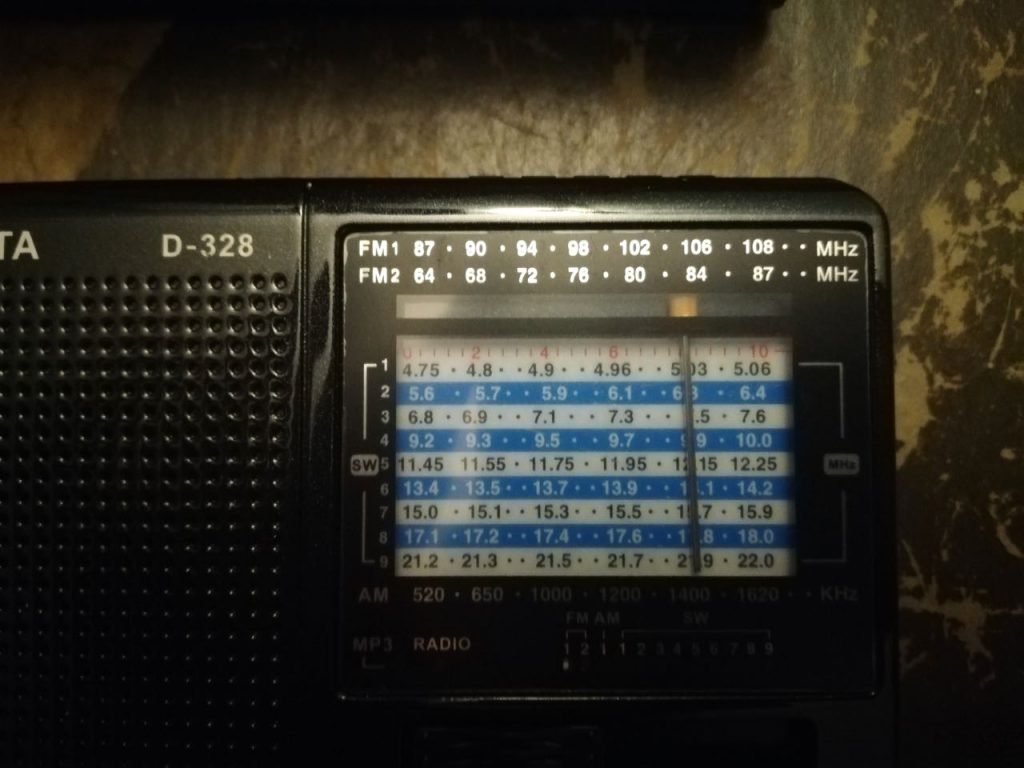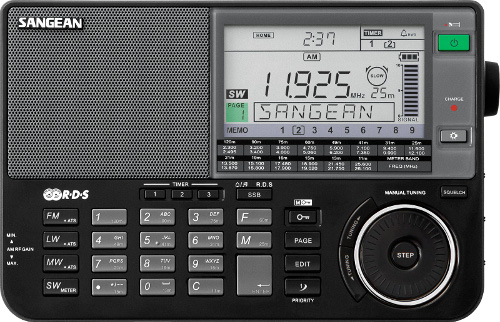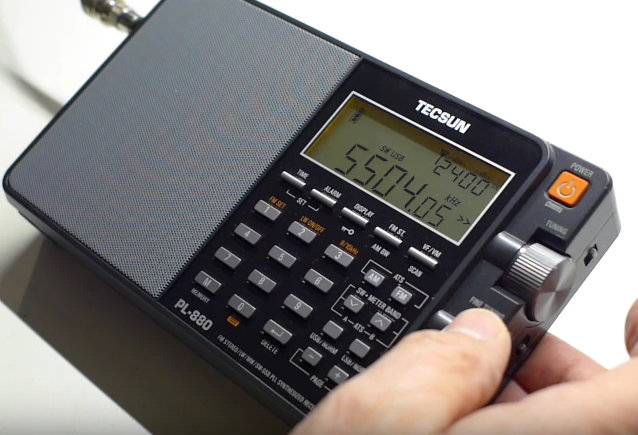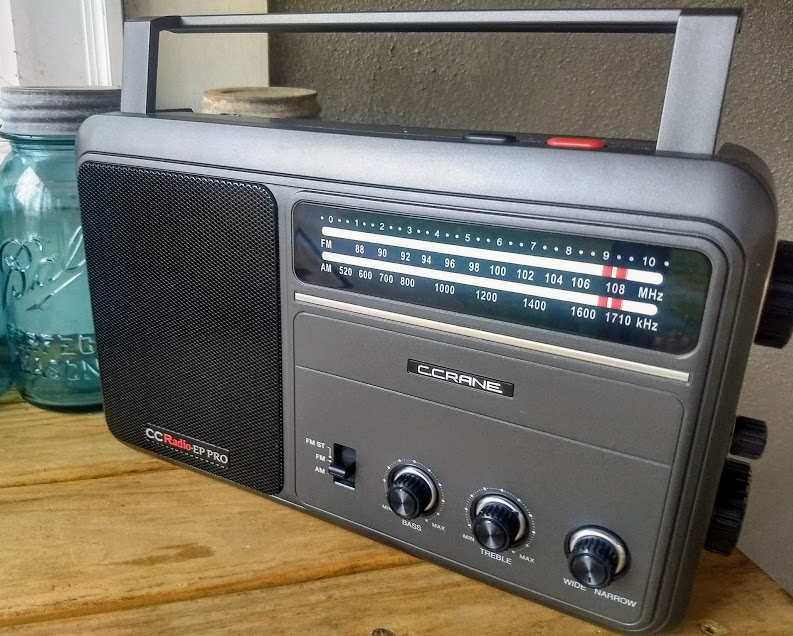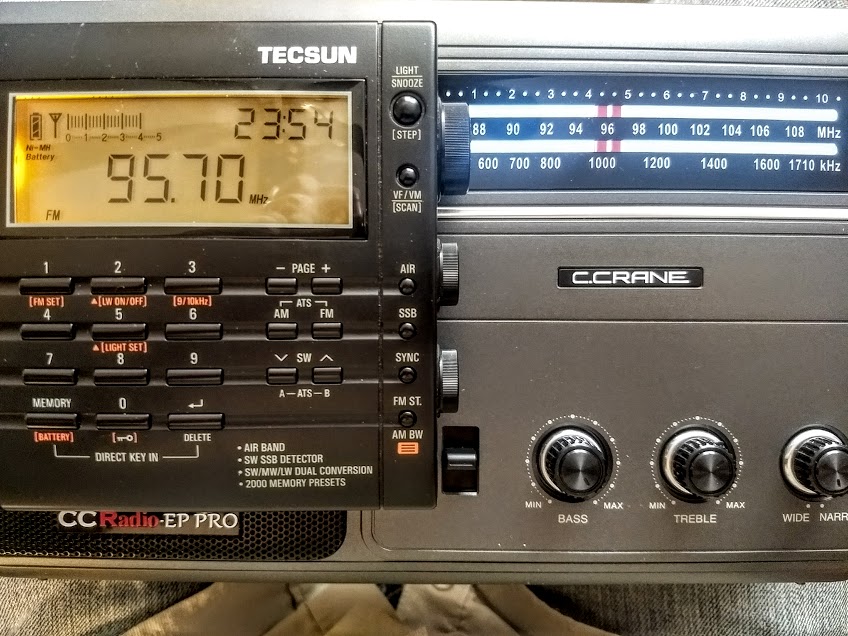Amazon has just posted an excellent price for the Eton Grundig Edition Traveller III shortwave portable: $35.83 shipped! This is the lowest price I’ve seen for the Traveller III since December when it hit this lowest price for a very brief period of time. As with any Amazon spricing, this could end at any time.
Radio Deal: Eton Traveler III $35.83 shipped via Amazon.com
The XHDATA D-808 and longwave: how to build an effective antenna
Many thanks to SWLing Post contributor, Mad Radio DXer, who writes:
I said I would share my results for attempting to receive LW signals on the XHDATA D-808, & if I can use a longwire to improve reception on this radio. This was after posting videos when I used around 50 metres of longwire connected to the D-808 for improved Medium Wave reception & to prove it works.
This first video shows that it is not possible for LW, no matter if I connect the 50 metres longwire to the 3.5mm input or the whip antenna. I also compare reception of the same station with the Degen DE1103 PLL using the 3.5mm input. The Degen DE1103 still had better reception even when I used the whip antenna extended at the very minimum when using the LW/MW external antenna trick. I know I should have used the internal ferrite antenna of the Degen compared to the D-808, but in any case I did try off camera & reception was about the same. So unfortunately the D-808 was never going to win this round.
However, there is a solution.
The answer? Build yourself a Long Wave induction antenna as shown in the second video [below]. I made one some time ago, as I grew frustrated at how poor the Tecsun radios were on this part of the band & that there were no LW induction antennas available to buy. I tried a signal on 207 kHz which is RÚV Rás 2 from Iceland. Either a radio with a very good internal antenna or a good external antenna is needed to receive this station at my QTH in southern England.
Placing the D-808 on the induction antenna resulted in a very pleasing result, which was it did get reception of Iceland on 207 kHz. So this shows that it is possible to DX on the LW bands with the D-808 with some “external help”.
For anyone interested making a LW induction antenna as shown above, here is a link to a video that has basic instructions & further results. It may be a very simple build & finish what I did, but for me the most important thing is that it works.
I hope my comments & videos will be a great help to all. Happy DXing.
Regards,
Mad Radio DXer.
Excellent–your comments and videos are most welcome! There are quite a number of SWLing Post readers who are avid longwave DXers. I love the simplicity and efficacy of your longwave antenna–something anyone could build. A clever upgrade to the affordable D-808. Thank you for sharing!
Radio Deal: TIVDIO V-115 $18.99 US shipped
I just noticed that the price for the TIVDIO V-115 has been lowered to $18.99 US shipped on Amazon.com.
Click here to read our previous reviews of this radio. This is the lowest price for the V-115 I’ve seen on Amazon. As I mention with any Amazon sale–a now standard disclaimer–the price could change at any moment.
A review of the Tivdio HR-11S self-powered shortwave radio
A few months ago, the radio manufacturer Tivdio contacted me to see if I would be interested in evaluating their new Tivdio HR-11S self-powered emergency radio. I receive requests like this frequently, and often pass on the opportunity since I generally don’t have the time to evaluate the overwhelming number of inexpensive DSP radios that have hit the market in the past few years.
But this time, I seriously considered it. There were two reasons I was interested in the HR-11S:
- I purchased a Tivdio V-117 last year, and have been pretty pleased with it; indeed, I’m overdue a review on this unit. We’ve also posted several positive reviews of the Tivdio V-115.
- At our non-profit ETOW, we’re always looking for reliable self-powered radios with shortwave for use in areas of the world where radio remains the primary news source.
Thus this radio is a rather rare breed. Tivdio dispatched the radio very quickly, but my work with the Radio Spectrum Archive and several other reviews already in the pipeline took priority.
I’ve had the HR-11S in service for several months, and have now explored every feature to some degree. What follows is my summary and review notes.
Green and Red radios are different models
First things first: note that I’m reviewing the Green HR-11S. Tivdio also makes a Red version which is actually a different model number: the HR-11W.
The main difference between these models, as I understand it, is the green HR-11S is a shortwave version, and the red HR-11W is a NOAA weather radio version.
Both are useful; why not combine the two roles in one unit? I’m not surprised this radio can’t include both shortwave and NOAA weather radio. Through Ears To Our World, I’ve worked with self-powered DSP radios for many years, and know that a limitation of the DSP chip is that it can be set to feature either shortwave or weather radio, but not both, simultaneously, if both AM and FM are included.
Form factor
The HR-11S adopts the standard “flashlight” form factor found in so many other self-powered radios. I think the flashlight functionality is a useful feature and results in a handy form factor. It’s compact, lightweight, and seems relatively sturdy, so is suitable for camping, travel, and off-grid utility.
A small switch on top toggles between four positions. The first two positions are off/on for the main white LED. Though the flashlight aperture is relatively small, the white LED provides enough luminosity to light your immediate path at night, and certainly more than enough to read by.
The third switch position engages a flashing red LED. The red LED is not terribly bright and I’m not sure how helpful this would be in an emergency situation.
I would much rather have the red LED maintain a steady beam which would be great for amateur astronomers, campers, or anyone else wishing to preserve their night vision.
The fourth position engages a LOUD siren. More than once when attempting to turn on the flashlight in the dark, I’ve accidentally engaged this pain-inducing feature. The switch is small, thus it’s very easy to engage the siren. In a quiet campground, this might annoy your neighbors––not to mention you, yourself. Of course, in an emergency situation, a loud siren could come in handy. I just wish its switch wasn’t combined with the flashlight switch.
The display HR-11S display is backlit and easy to read.
The HR-11S sports a keypad that allows direct frequency input––a very good thing, considering there is no tuning knob.
To band scan, you must use the #7 and #8 key on the keypad to increase and decrease frequency in predetermined steps. And, yes, the radio mutes between frequency changes.
You can also press and hold the #7 or #8 buttons to engage an auto-tune feature that finds the next strong signal.
To input a frequency directly, simply press the enter button, key in the frequency, then press the enter button once more to engage that frequency. Very simple.
The volume up/down buttons are #1 and #2 on the keypad.
The keypad is not backlit and the layout for volume control, tuning, mode switching, etc., is a bit confusing; it doesn’t match any other radio I’ve ever used. Of course, with time you’ll master the keypad functions, but the design could be made more user-friendly.
Performance: setting expectations
SWLing Post community members know that I tend to review what I call “enthusiast grade” radios: receivers that perform well enough to attract the attention of DXers and dedicated listeners.
Self-powered radios, with few exceptions, rarely impress me in terms of performance. Indeed, some of the best that have been on the market have been analog units (I’m particularly fond of the Grundig FR200).
The Tivdio HR-11S is no exception––don’t expect to snag elusive DX with this unit. It’s not going to happen.
FM
The HR-11S is a capable FM receiver. Performance is on par with most average FM radios: you’ll easily receive all of your local broadcasters, but distant stations may require holding the unit in your hand, careful positioning, or adding an extra bit of wire to the antenna.
The FM audio is quite good via the HR-11S’s built-in speaker.
AM
The mediumwave, or AM broadcast band, is the HR-11S’ weakest suit. AM is plagued with internally-generated noises–especially in the lower part of the band–thus you’ll only be able to clearly receive local AM broadcasters that rise well above the noise floor. Thus I cannot recommend this radio for AM reception.
Shortwave
Shortwave reception is on par with other DSP self-powered radios I’ve tested. As I write this section of the review, I’m listening to China Radio International on 9,570 kHz in my office without even having the telescopic whip antenna extended. (CRI is a blowtorch station, however).
I find that the HR-11S can receive most strong broadcasters and even weaker stations, though the AGC is not ideal when fading is present.
If you’re seeking a self-powered radio with shortwave, the HR-11S is somewhat useful in this regard and is worth consideration.
Keep in mind, though, that an inexpensive dedicated ultralight shortwave radio like the Tecsun PL-310ET will perform circles around this unit.
Bluetooth
One feature I’ve found incredibly useful is the Bluetooth functionality. With Bluetooth mode engaged, you can connect the HR-11S to pretty much any mobile device and use it as a wireless portable external speaker. Since the speaker has decent audio fidelity for the size, and can be powered by battery, it’s a brilliant feature and will make watching videos on your smartphone, for example, that much better.
One negative? At least in my unit, I can hear some internally-generated noises in Bluetooth mode. This is especially noticeable at lower volume levels.
Recording
In full disclosure, I haven’t tested the recording functionality extensively. Built-in radio recording is an interesting feature, but one I would rarely use in a self-powered radio. I did make a handful of test recordings, however, and like many other DSP radios with a recording function, the HR-11S injects noise in the recordings.
Summary
Every radio has its pros and cons. When I begin a review of a radio, I take notes from the very beginning so that I don’t forget my initial impressions and observations. Here’s the Tivdio HR-11S pro/con list, from the first moments I turned it on to the present:
Pros:
- Keypad entry
- Great audio for size
- Replaceable battery (Note: after unboxing unit, you must place battery in battery compartment; it’s packed in the side box)
- Siren (see con)
- Micro SD card for digital storage
- USB can port audio from PC
- Bluetooth––use as a portable wireless speaker for mobile devices (see con)
- ATS (auto tune) function
- Multiple power sources:
- 850mAh rechargeable lithium battery
- hand-crank dynamo generator
- Mini solar panel
- DC 5V input (standard micro USB)
- Backlit informative display
- Customer service: Tivdio representatives seem to respond quickly to customer emails and comments on Amazon.com.
Cons:
- Tuning is cumbersome (no tuning knob)
- Mutes between frequencies
- Siren too easy to activate, resulting in accidental activation
- AM broadcast band (MW) is plagued with internally-generated noises
- Keypad configuration is not intuitive and difficult to memorize for use at night or low light settings
- Hand strap is very difficult to insert (hint: use a thin loop of wire to help thread it)
- At low volume, noises can be heard in Bluetooth mode
- Noises heard in recording function
Conclusion
As I mentioned early in this review, I must set realistic expectations when reviewing self-powered radios. When most consumers consider a self-powered radio, they’re seeking a simple, basic radio that will provide information during times of need: power outages, natural disasters, or while hiking, camping, boating, or simply in an off-grid setting.
Internally-generated noises––especially on the AM band––will disappoint radio enthusiasts. If Tivdio could address this in future iterations of the HR-11S, it would substantially improve this unit.
My overall impression is that the HR-11S is chock-full of features, but none of them are terribly refined. There are even some internally-generated noises in Bluetooth mode, which really surprised me as it seems like an oversight by engineering.
I see the Tivdio HR-11S is a bit of a “Swiss Army Knife” of a self-powered radio. It has more functionality and connectivity than any other self-powered radio I’ve tested to date. Its features will, no doubt, appeal to the average consumer––and a quick look at Amazon reviews seem to support this theory. As a radio enthusiast, however, I would pass on the HR-11S until the internally-generated noises have been addressed.
Click here to view to the Tivdio HR-11S on Amazon.com (affiliate link supports this site).
See coupon codes below.
For those who are interested, Tivdio passed along several coupon codes that SWLing Post readers can use to save money, should they decide to purchase the HR-11S:
For a 5% discount, use code:
- LEAMBPRI for the UK HR-11S
- D3E2FSN5 for the US HR-11S
- PY2N62VN for the US HR-11W Radio
- PY2N62VN for the 5% discount for Canada HR-11S and HR-11W
Portable SSB radios for people who are visually impaired
Many thanks to SWLing Post contributor, Svein Tore, who writes:
I’m blind. The type of shortwave radio I like best, is the analogue type with a tuning wheel, because I don’t need sight to use it, and I have full control over the receiver.
I would like to buy a radio with SSB, but it seems that all of the radios with SSB are digital, and you need to see the display to use the radio.
Are there any analogue radios with SSB?
If not, what is the simplest radio receiver with SSB?
I’m looking for a radio with as few functions and menus as possible, but it should have SSB.
I’m looking for a small or medium sized receiver, but if you are thinking of a big radio that seems to be right for me, please tell me about it.
Perhaps I have given you an impossible question now? I’m sorry for that.
Thanks
Greetings from Norway.
Svein Tore
Excellent question, Svien. I thought it would make sense to share your inquiry with the SWLing Post community as I know we have other readers who are visually impaired. Readers, please comment with any suggestions you may have.
To my knowledge, there are no analog shortwave radios with a BFO (for SSB) that are in production today. There are, however, numerous analog models from the 60s, 70s and 80s with a BFO (two examples: the Sony ICF-5800H and the Panasonic RF-2200).
In fact, my first proper radio was a Zenith Transoceanic. I’ll never forget taking it to our local RadioShack, when I was eight years old, to ask one of the employees (who I knew was a DXer) what the heck “this strange BFO knob” does!
There is the analog Sony ICF-EX5MKII that SWLing Post contributor Troy Riedel reviewed, but I don’t believe it has a BFO–only a synchronous detector which can be switched between upper and lower sidebands. Perhaps a reader can confirm this.
Since I can’t recommend a current analog model, I do have a digital solution that I believe may work for you:
The Tecsun PL-660
Though not an analog radio, the menus on the PL-660 are not “deep”–most buttons simply toggle features. There is no hardware “switch” to change bands, but I think you would find it easy enough to use the direct frequency entry keypad to navigate across the spectrum. The SSB feature works more like an analog radio as it has a BFO dial on the right side of the radio. The buttons and dials are also raised and tactile. Best yet, the tuning sounds like an analog radio since there is no muting between frequency changes.
There are a number of other portables out there that are about as simple to operate as the PL-660, but I like the price point of the PL-660 and its overall performance characteristics. For a little less money, and a similar form factor and function set–minus a synchronous detector function–you might also consider the Tecsun PL-600 as well.
Again, I’m hoping Post readers might chime in with even better suggestions! Please comment!
The Sony ICF-M780SL: Peter catches some serious MW DX on Gran Canaria
Many thanks to SWLing Post contributor, Peter Wilson, for sharing the following guest post and DXpedition report:
Sony ICF-M780SL MWDX on Gran Canaria
by Peter Wilson
I have spent the last two months in Las Palmas, Gran Canaria adjacent to the Atlantic Ocean.
I travelled light and didn’t bring my radio/SDR collection with me.
A portable I saw in a local department store caught ny eye, and I ended up buying one from a local electronics retailer which had it on special at €55. It is a Sony ICF-M780SL which as turned out, is something rather special. It is a four band (LW, MW, SW,FM) DSP receiver, with an AM IF (LW, MW,SW) of 45 kHz and an FM IF of 128 kHz.
There’s too much hash in my apartment block to use it at home, but as I am a couple of streets away from the Ocean I intended to use it there.
Problem is there almost as much RF hash at the oceanside as at home. Also the Atlantic breakers crash loudly on the shore, and the wind can howl quite loudly. I did have some limited success and have included a couple of clips.
I discovered a better DX location at a small Plaza a short distance inland from the Ocean. There is an early morning peak for MW TA leading up to about 07:30 UTC (= local time)
The radio is used barefoot in each clip. There is some camera hash.
Here are the highlights:
USA Transatlantic
1500 WFED booming with ID 5736 km
Click here to view on YouTube.
790 WAXY with ESPN Radio ID 6369 km
Click here to view on YouTube.
1540 KXEL 6935 km
Click here to view on YouTube.
1530 WCKY 6373 km
Click here to view on YouTube.
770 WABC 5459 km
Click here to view on YouTube.
1520 WWKB
ESPN Radio with sports talk. 5841 km
Click here to view on YouTube.
Ocean front around dusk
1350 TWR Armenia 5377 km
Click here to view on YouTube.
1521 Duba Saudi Arabia 5004 km
Click here to view on YouTube.
1458 Lyca Radio, Brookmans Park UK 2914 km
Click here to view on YouTube.
The Sony ICF-M780SL is a great MW/LW/FM performer. SW propagation has been mediocre and suffers from the RF hash QRN, so difficult to test.
Amazing, Peter! It’s hard for me to believe the reception you had of WFED (Federal News Radio). I listen to that station every time I go through the DC/Baltimore area and I think your reception is just as good. A TA crossing of almost 5,000 km with armchair copy! Quite an accomplishment!
Thank you for sharing your Gran Canaria DX with us. I’m pretty impressed with the Sony ICF-M780SL as well.
Post Readers: make sure you check out Peter’s YouTube channel by clicking here.
Click here to search Amazon.co.uk and click here to search eBay for the Sony ICF-M780SL.
Radio spotted in “The Day the Earth Caught Fire”
Many thanks to SWLing Post contributor, Mark Hirst, who has discovered yet another radio in film:
Spotted this in the 1961 sci-fi movie, ‘The Day the Earth Caught Fire‘.
I’m guessing it’s an old military set.
I believe it is indeed, Mark! Perhaps an intrepid SWLing Post reader can sort out the model number? Please comment!
I’ll add this post to our growing archive of radios in film.
Guest Post: Radios I Have Known #2
Many thanks to SWLing Post contributor, Neil Goldstein, who shares the following guest post which originally appeared on his blog, Fofio:
Radios I Have Known #2 The old, the new, and the Select-A-Tenna
by Neil Goldstein
After promising this series a year and a half ago, I finally have started digging through the collection, and will start posting about once a week. The radios, and accessories may not have anything in common (as seen in this post), but were all acquired because they were in some way interesting, or sentimental to me. Here’s the first three:
Select-A-Tenna
One of the original air-core tunable AM antennas. You just put this near the radio and peak it for reception. I was watching for one of these in good shape, and not overpriced, and they have been in and out of production over the years. This one is from a later production run as can be seen by the extended AM range (1700). Jay Allen reviewed the S.A.T by comparing the the TERK Air Core antenna not long ago here: https://radiojayallen.com/select-a-tenna-vs-terk-am-advantage/ The TERK reviewed well, and looks more modern, but I wanted the classic cheesy art-deco looking S.A.T.
Tivdio V-115
I won’t post a long, boring review here. Many have already reviewed this radio. All I can say is that if you like small, decent-sounding transistor radios, you will not be disappointed. If you are expecting top-shelf performance, and perfect ergonomics, then you you may not be happy, but for around $19 you really should be happy with this little gem. A great little radio at a great price and the most impressive thing here is the sound. The radio has a small passive radiator like the Meloson M8, and M7, and really surprises me. It can also be used as an amplified speaker, and has a micro SD slot for using it as a standalone MP3 player. Grab one!
Sony ICF-5500W
Most transistor radio collectors know this radio. It’s a classic for sure, but I have to give a little background on why I wanted one. When I was about 12 years old, I had a few analog SW portables, but nothing with direct frequency readout. Panasonic had introduced it’s series of direct-readout radios, the RF-2200, 2800, and 4800, and Sony was competing with the ICF-5900W. Dad acknowledged the quality and technology of these radios, and told me that if I saved most of the money by working for him, he may help me get one. The 2800, and 4800 were way out of reach, but one Sunday in the local paper, a department store in Kingston (Britt’s, which was Newberry’s answer to Macy’s) had the 2200 advertised for $138.88. I had been flip-flopping between the Sony and the Panasonic for weeks, but that was the clincher.
The radio is still in use. My sister in law has it. I had given it to my late brother Paul at some point and she still uses it as her main radio.
Why this Sony though? I still want a 5900W. When I saw this one come up at an auction, I recognized the shape it was in. The ICF-5500W was the companion radio to the 5900W. AM/FM and VHF Hi (with a basic, but functional squelch control). The 5500 and 5900 are a monument to Sony design at the time. The pop-up antenna (which still works flawlessly), The separate Bass, Treble, and Loudness controls, The overall quality of sound and function, all of this is an example of what Sony was producing at the time. I think their modern small electronics are a shadow of what they were capable of years ago. This thing still sounds great and performs well next to my modern DSP radios. I still would love to get a pristine 5900W but they usually fetch premium dollars. Maybe someday.
Bravo Sony, but where did you go?
More to come!!
Thanks for sharing, Neil! I, too, have the Tivdio V-115 and the Sony ICF-5900W.
The ‘5900W is a gem of a solid state receiver. It has brilliant AM broadcast band reception and rich audio. I need to open my ‘5900W and clean all of the contacts since some of the sliders are scratchy. It’ll make for a nice rainy day project!
We look forward to your next installment! Post Readers: be sure to check out Neil’s blog, Fofio!
What’s Up with the XHDATA D-808 Availability in the USA?
After the initial flurry of reports, interest, and purchases of the XHDATA D-808 portable receiver by radio enthusiasts, the door on USA shipments seems to have slammed shut.
This fine DSP-based portable went live in early December 2017 for USA purchasers when it was offered by AliExpress for $69.98 with shipping. Later, the RadiWow site started selling the radio for nearly the same price including USA shipping.
Now in mid-March 2018, the D-808 is nowhere to be found on AliExpress:
Sure, the RadiWow firm still ships the D-808 to the USA, but for a ridiculous “we don’t really want your business anyway” price. (A company that has a product page with “LOGO” in the corner is certainly not paying attention…perhaps they meant to enter “USD $20” as the cost? :^)
My hope is that XHDATA is working on an exclusive USA distributorship, such as Kaito Electronics Inc. has in this country for Kaito radios, or perhaps the D-808 will eventually be found only on Amazon USA. Maybe the highly regarded EBay seller Anon-Co (Anna) is at work behind the scene to offer this model exclusively.
What’s going on here? Please leave your thoughts in the comments section below.
Guy Atkins is a Sr. Graphic Designer for T-Mobile and lives near Seattle, Washington. He’s a regular contributor to the SWLing Post.
Radios spotted in The Walking Dead series
Many thanks to SWLing Post contributor, Balázs Kovács, who notes that he discovered, “some radio equipment in the latest episode of The Walking Dead series”:
Can anyone ID the rigs above? Please comment!
I’ll add this post to our ever growing archive of radios in film.
William spots radios in “A Quiet Place”
Many thanks to SWLing Post contributor, William Lee, who writes:
Upcoming full release of the 2017-2018 film “A quiet place”
https://en.wikipedia.org/wiki/A_Quiet_Place_%28film%29
and
https://www.imdb.com/title/tt6644200/It has some pictures in a local film-publicity magazine, one of which is Emily Blunt in front of a whole collection of old professional radios.
See some images can be found here.
“So the father’s basically setting up all these different safeguards to keep the family safe. So he set up basically, for all intents and purposes, a war room down in the basement of their house that’s underground. Underground is a lot safer than above ground because you make less noise.
[…]He’s basically, over the years, collected TVs and radios and all these different things that he can try to make contact, try to get information – obviously no volume on any of them. The TVs are actually a security network where he’s put up cameras all over the farm, so he can see where everyone is at all time.”
There are probably more radio pictures elsewhere.
Thanks for sharing, William! Looking through some of the screen shots, I do see at least one transceiver (image at top of page) but I can’t make out the model or manufacturer. I also see a number of scopes. I’m sure there are many more radios in this film!
I’ll add this post to our growing archive of radios in film.
Dave’s review of the AOR AR-DV1 Digital Voice Receiver
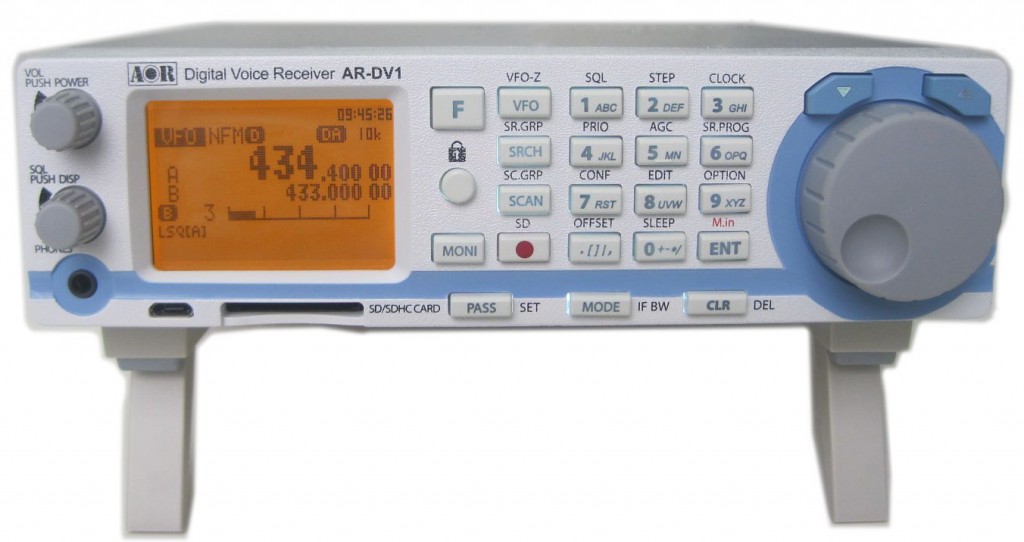 Many thanks to SWLing Post contributor, Dave Zantow (N9EWO), who has recently posted his review of the AOR AR-DV1 digital voice receiver.
Many thanks to SWLing Post contributor, Dave Zantow (N9EWO), who has recently posted his review of the AOR AR-DV1 digital voice receiver.
As with many of Dave’s reviews, this evaluation takes a close look at HF and mediumwave performance which isn’t the AR-DV1’s strong suit. Dave notes:
“[Though] not what the receiver was designed for, RF performance on MW / HF bands (and the terrible audio quality) are mediocre at best.”
Click here to read Dave’s review.
Thanks, Dave! Your review reflects comments I’ve received from some Post readers who’ve purchased the AR-DV1 as well. Many were particularly upset with the audio quality. Of course, the AR-DV1 is marketed as a digital voice receiver, thus audio likely favors “narrow” voice audio.
The new Tivoli Model One Digital has AM (for Australians only)
Many thanks to SWLing Post contributor, Dennis Dura, who shares the following article from The Sydney Morning Herald (my comments follow):
Australians like AM radio, but it’s just about impossible to find a good quality digital radio with AM. Lots of digitals get FM, so why no AM?
It’s because Australia is an unusual market for radios. We’re not like Asia, Europe, Japan and America where practically all radios are designed and manufactured. These places have large populations in high densities, and one population hub is seldom far from the next. The range limitations of both digital and FM are seldom an issue.
But in Australia we have digital broadcasting only in the capital cities, meaning Brisbane’s digital radio stations are 900 kilometres from the next nearest in Sydney, leaving about 800 kilometres of dead air between. Digital can’t even hold between Sydney and Canberra. FM lasts a bit longer, not much. But with good old AM you can listen to Darwin from the Nullarbor Plain when the conditions are right. Through vast tracts of Australia if you don’t have AM you don’t have radio.
So Gary Tye’s challenge when he took on distribution of the Tivoli brand was to convince people in Boston that Australians will actively seek out and buy a digital radio with AM. They took a lot of convincing.
And so the $449 Tivoli Model One Digital is now available with AM, as well as FM and digital. But only in Australia. Caravanners around this wide brown land will rejoice; there’s at last a good sounding digital radio that will work anywhere.
[…]The sound quality is, as a very honest department store salesman observed, good but not great. I remember the original as being better. The bass can become ragged down low and the definition gets a bit fuzzy at high volumes, but for filling a study, a kitchen or indeed a caravan with good music the Tivoli does an entirely respectable job. It’s not on a par with a Wave Radio but it costs half as much and sounds better than the vast bulk of radios, be they digital or analogue. And it has AM.
It also has Spotify, Tidal, Deezer and Wi-Fi to get internet radio. There’s Bluetooth and you can hook in your phone or music player with a cable to the 3.5 mm auxiliary input.
Click here to read the full article at The Sydney Morning Herald.
Thanks for the tip, Dennis!
I owned the original Tivoli Model One and loved it. I recently gave it away while thinning the herd here at SWLing Post HQ. Though it was an elegant, simple radio with excellent audio characteristics, so is my Como Audio Solo which essentially replaced the Model One.
While the Model One Digital is appealing in many respects, reviews are lukewarm at best. Customers complain about the proprietary app, the audio being too heavy on processed bass and the overall performance not matching that of its predecessor.
While the Model One Digital is a “WiFi” radio, it doesn’t seem to connect to any of the streaming radio station aggregators we radio enthusiasts rely on to tune to our favorite obscure local stations on the other side of the planet. It appears to only connect to paid music streaming services and one’s own local digital library (though please correct me if I’m wrong about this!).
Post readers: Any Tivoli Model One Digital owners out there? I’d love to read your reviews!
An initial look at the C. Crane CCRadio-EP Pro
Earlier this week, I took delivery of the latest radio from C. Crane: the CCRadio-EP Pro. C. Crane sent me an early production model for evaluation.
Since posting an announcement last November, several SWLing Post readers have contacted me and asked if I would take a look at this next iteration of the venerable CCRadio-EP.
Yesterday, I started a proper evaluation of the EP Pro by taking it to a park where I compared it with my trusty Tecsun PL-660 on AM/mediumwave.
First impressions are favorable in terms of sensitivity, stability and audio, but with a number of caveats.
The EP Pro is not a true analog set like its predecessor–it’s based on the Silicon LabsSI4734 DSP chip.
In other words, much like the Degen DE321, the Degen DE32, the Tecsun R-2010D, the Kchibo KK9803 and the ShouYu SY-X5 (which I review in a shoot-out here), the CC-Radio EP Pro is a mechanically-tuned DSP receiver.
On the plus side, the new EP Pro will not drift like its analog ancestor (a common complaint from EP owners).
But truth be told, I’m not the biggest fan of mechanically-tuned DSP radios. Why? For one thing, it’s nearly impossible to eliminate muting between 10 kHz frequency steps on the AM band. Note here that the EP Pro is fixed at 10 kHz steps, though C. Crane tell me a future production run will have a 9/10 kHz step toggle.
Additionally, the EP Pro produces false peaks/images on either side of a strong AM or FM signal. In fact, C. Crane includes the following informational insert with the EP Pro:
This is going to be a quirky radio.
The tuning mechanism is…well…unusual…and takes some getting used to. I’ve also discovered that the top half of the AM dial is inaccurate. Here’s the EP Pro centered on WTZQ at 1600 kHz:
 I estimate that the slide rule dial is off by about 40-50 kHz at the top end of the band. It’s much more accurate below 1,200 kHz, however. I plan to hook the EP Pro up to a signal generator and note the results in my forthcoming review.
I estimate that the slide rule dial is off by about 40-50 kHz at the top end of the band. It’s much more accurate below 1,200 kHz, however. I plan to hook the EP Pro up to a signal generator and note the results in my forthcoming review.
Speaking of an EP Pro review, I plan to publish it within the next two weeks, so stay tuned!
Follow CCRadio-EP Pro posts by bookmarking this tag: CCRadio-EP Pro
Click here to check out the CCRadio-EP Pro on C. Crane’s website.
The Muzen OTR: initial look and impressions
A lot of SWLing Post readers have been contacting me lately noting that they’ve received their Muzen OTR/Radio Caroline FM radio and Bluetooth speaker.
Muzen started shipping the new OTR to their backers this week.
I received my OTR yesterday and am completely in love with this little gem. Without a doubt, it’s one of the highest quality pieces of consumer technology I’ve purchased in years.
Yesterday, by request, I made an unboxing video–I plan to post it later today when I have a good broadband connection.
I’ll also follow up with a proper product review, but I can say now that the Muzen OTR has amazing audio fidelity for such a tiny little unit–it’s room-filling. The FM tuner works well (although the dial is tiny). The solid wood chassis is beautiful, refined and sturdy.
The OTR shipped with the highest quality leather carrying case I’ve ever received with a product. It smacks of 1960s quality (or even better!).
The OTR is a salute to the famous Radio Caroline–as a nice added touch, they even include a tribute in the form of a QSL card.
The Muzen OTR package also includes an audio cable, USB cable, and FM antenna.
What a pleasure to receive such a quality piece of kit! Look for my review soon.
Post readers: Did you back the Muzen OTR as well? Received your unit yet? Please comment!
Video: Band scanning with the C. Crane CCRadio-EP Pro
 I’m in the process of writing up a review of the C. Crane CCRadio-EP Pro, but a number of readers have been asking about how pronounced muting is between frequencies while band scanning.
I’m in the process of writing up a review of the C. Crane CCRadio-EP Pro, but a number of readers have been asking about how pronounced muting is between frequencies while band scanning.
To be clear, the CCRadio-EP Pro is not a true analog set like the original CCRadio-EP (even though it looks like an analog set). The EP Pro is based on the Silicon Labs SI4734 DSP chip, hence the frequency steps in 10 kHz increments and are not fluid/seamless as they would on analog sets.
Muting is more pronounced on the AM broadcast band than it is on the FM band. Here are two video demonstrations:
AM Band Scanning
Click here to view on YouTube.
FM Band Scanning
Click here to view on YouTube.
The audio “pop” that I note (when the CCRadio-EP Pro is first turned on) is bit annoying and can even be heard in nearby radios if they’re on. While doing my comparisons with the Sony ICF-5500W and the Tecsun PL-660, for example, the audio pop could be heard in both units as I turned on the EP Pro. I’m willing to bet this is only prevalent in the DSP chip version of the EP series.
Follow CCRadio-EP Pro posts by bookmarking this tag: CCRadio-EP Pro
Click here to check out the CCRadio-EP Pro on C. Crane’s website.
Guest Post: A review of the XHDATA D-328 portable radio
Many thanks to SWLing Post contributor, Aaron Kuhn, who shares the following guest post:
XHDATA D-328 Radio Review
by Aaron Kuhn
Disclosure: This radio was supplied at a 99% discount by the manufacturer, costing me only $0.15.
About Me
I live in the Philadelphia Suburbs, where there’s ample FM Stations, good AM Coverage, and also a lot of noise when it comes to Shortwave. I’m mostly an AM/FM listener, who occasionally likes to dabble in Shortwave. My idea of a good radio is something I can turn on, put up the antenna, and it just works.
Initial Impressions
The Radio is boxed simply enough in a cardboard box, with a small amount of bubble wrap inside, manual, Mini-USB Cable. The Lithium-Ion Battery comes pre-installed.
Operation of the radio is mostly straight-forward, and I doubt you’ll need the manual for anything. The manual itself contains your normal badly-translated English phrases and doesn’t make sense in a lot of places (did you know this radio uses high quality PU edge big size?)
Two curious notes about the manual:
- It mentions you should remove the “18650 Lithium Ion Battery”, but this radio doesn’t use an 18650 battery. Instead, this radio uses a “BL-5C” Battery, which based on my research looks like it was pretty common on Nokia phones around 2004.
- Someone took white-out to the manual where it says “Set the function switch to the “MP3” position and insert the USB Stick or TF Card, with “USB stick” covered in white out.
The radio itself is made of a slippery, glossy plastic that doesn’t inspire confidence, but also seems to have enough structural stability it doesn’t worry me. I’d guess this radio could take a moderate drop and bounce and be OK, but it’d probably crack if dropped from above waist level.
I ran into a somewhat funny problem trying to insert the included wrist strap into the hole in the back of the radio. Unlike most radios with a wrist strap hole that’s closed off, the wrist strap instead continued down into the radio. That is, the wrist strap “loop” molded in the plastic is actually a hole into the radio. This doesn’t bode well for dirt or other junk getting pushed into the radio accidentally. I was able to eventually get the wrist strap on the loop, but it was far harder than it should have been.
Design
The Lithium Ion battery comes pre-installed in the radio, and the battery door it’s behind seems sturdy enough. Fortunately, there’s really no reason you should ever have to pull the battery out of this radio unless you need to replace it. Running the Battery model # across Google and other sites shows this should be a very cheap battery for you to replace at between $1 and $3.
I very quickly noticed a big glaring design flaw on this radio with the poorly designed, super small kickstand located next to the battery compartment. This small, off to the left kickstand works fine if the radio is on a perfectly level surface like a nightstand, but causes the radio to tilt over if you try to place it on a soft surface like a bed or a pillow. I would have liked to see just one large combination battery door/kickstand if possible across the back of the entire radio.
Design problem number two with the radio became very apparent when trying to extend the telescoping antenna. The antenna butts up against the plastic molding on the back of the radio, meaning you cannot prop the antenna up “Straight” when using the kickstand. This results in the antenna having to angle off at around 45 degrees, which is a bit annoying. My Tecsun PL-310ET doesn’t have this problem due to having a cut-out notch to allow the antenna to be in a more upright position.
The tuning knob has a satisfying amount of resistance to it, and doesn’t spin too quickly or too slow. The volume knob, while smaller, spins freely and also feels solid.
The band selector selects between FM1-2, AM, and SW 1 through 9. The switch to move between these bands has a satisfying amount of click and feedback to it, and isn’t mushy and you likely won’t pick the wrong band. The small window displayed below each band number fills with a small, mechanical, plastic bar attached to the switch. The window and bar were slightly misaligned, making it difficult to tell at a glance which band I had selected.
The tuning bar itself moves smoothly across the band, but the metal extension piece running down the shortwave part of the spectrum tuning was not vertically straight and had a noticeable bend to the lower right.
Weight – this radio is INCREDIBLY light! The choice of a Li-Ion rechargeable battery pays off here, and when I weighed the radio it came in at exactly 160 Grams / 5.7 Ounces. The compact size of this radio and the weight would cause it to easily disappear into a coat pocket and I’d forget I was carrying it. This definitely qualifies as super-portable in my book.
The choice to use Mini-USB instead of Micro-USB on the charging is a questionable one. Micro-USB is the much more common connector you’ll recognize if you’ve bought a Smartphone in the last 3 years, or any other consumer device with a USB connector. Based on my short research, Micro-USB despite being smaller than Mini-USB, offers a number of benefits including increased cycle-count on the number of plugs/unplugs before the connector wears out. I don’t know why XHDATA went with Mini-USB on this, and I’d suggest they move to Micro-USB for future revisions. The Mini-USB, other than being slightly easier to plug in, seems to offer no benefit and is obsolete compared to Micro-USB.
Audio Quality
Wow! While I may have had some hesitations about the radio’s design, I was incredibly surprised by both the loudness and fidelity of the speaker on this radio. The volume was incredibly loud, and the audio did not distort even when I turned this to the highest setting. While a mono speaker, voices on AM were quite clear and nice to listen to, and music on FM Sounded way better than it deserved to sound coming out of a $14 radio.
Plugging in a pair of earbuds (not included) also produced crisp, loud audio, with no noticeable whine or hiss. Volume levels should be more than adequate. Audio came in through both Left and Right earbuds, but I was unable to tell if the output was actually Stereo when listening on FM. The word “stereo” is not mentioned anywhere in documentation, so I would not be surprised to learn this radio is mono-only.
Tuning
I don’t normally use analog radios, so tuning the D-328 was a bit of a challenge. The cramped display provided little feedback, and the crooked tuning bar didn’t help either. FM Stations seemed to be needed to be tuned “high” About 1MHz from where I thought they should be, and AM Stations about 50 KH above where I thought they should land. Tuning Shortwave seemed like a total crapshoot, being fairly imprecise.
I’m mostly an FM/AM Radio listener, and all the usual local suspects popped right in and tuned easily for me. Static between stations is kept very low, and when a station locks in on FM it pops in very clearly. Selectivity between close adjacent stations can be challenging due to the small tuning dial and skewed visual feedback, but I was able to tune in every FM Station I tried.
I am located in the Philadelphia Suburbs, so my usual station for tuning in a weak signal is WPRB 103.9 out of Princeton. I’m happy to report it came in just as clear as it did on my Tecsun PL-310ET, with no trouble finding it.
AM was more of a mixed bag with tuning. Stations I did not expect to come in clearly seemed to pop in with strong signal strength, while the “go-to” AM Test station of KYW 1060 proved surprisingly difficult to locate on the dial. Audio levels on AM were noticeably wider in variance of signal, with some stations proving almost too quiet to listen to.
I’m honestly not much of a Shortwave listener most of the time, so I’m sure some other reviewers will go into much more detail on the Shortwave performance of this radio then I will. My experience tuning around on Shortwave with the D-328 was similar to AM, in that I had a lot of unexpected surprises in strong signals between 6900KHz and 9300KHz. My shortwave listening usually takes place on digital tuning with the Tecsun PL-310ET, so it’s hard to compare analog listening for something I don’t do that often. Tuning was surprisingly easy on the shortwave bands, but seemed frustratingly random where stations would show up.
MP3
Let’s get this out of the way immediately – this radio does not record MP3 files. Instead, sliding the mode selector to “MP3” will let you play files off a “TransFlash” (MicroSD) Card.
I’ll be up front here – this radio is a functional, but not fun to use MP3 player. I tested the MP3 player by loading up a 2GB MicroSD Card I had laying around with some files in a structure similar to the following:
* Root
** File1
** File2
** Folder1
*** Subfolder 1
*** File 3
*** File 4
** Folder2
** File 5
** File 6
** File 7
The first thing you’ll notice when playing MP3s is the “MP3” Light that is Red. And blinks. And blinks. Yes, the red light blinks continuously while playing an MP3 file and you can’t turn it off. This right here would annoy me to no end if I wanted to use this feature
My second problem with using MP3 functionality is that playback without a screen is a throwback to the days of the iPod Shuffle. And if this radio had “shuffle mode”, I’d be OK with that, heck that would even be fun – but there’s no shuffle here, only sequential play.
This radio does seem to follow the expected order of my files in playing them sequentially 1 through 7 across subfolders, but the lack of visual feedback makes it very easy to forget where you’re at and what you’re playing. Pressing and holding the fast forward button does work to fast forward, and rewind through individual mp3 files.
If you want to load up a MicroSD card with some old time radio episodes and play them back – this might be great. But I’d probably ask you why you’d ever want to play MP3 files on this thing. I mean, the feature is there…. But why? There’s much better devices and experiences out there for MP3 Playback rather than loading files onto a MicroSD card to play on a device with no screen. I imagine this might have some utility usages for playing MP3’s when you don’t want to sacrifice more expensive hardware, but I personally can’t see myself getting much usage out of the feature.
Conclusion
At the end of the day I have to ask myself – who exactly is this radio for? The price point and feature set seems to pit this against the very low-end of the AM/FM/SW Market such as the Analog Tecsun R-9012 at $22, and Tivdio Digital tuning units around $18. The inclusion of Shortwave, Mp3 Playback, and USB rechargeable battery gives this a leg up over budget AM/FM units, as well as the competitors mentioned.
Is the DX/radio hobbyist the target market for this radio? I don’t think so. While cheap (and we Shortwave/HAMs are a cheap bunch!), this radio lacks the sophistication or features a DX’er would want.
Is this a good “throw-away” radio for when you don’t want to risk your “Good” Radio? Absolutely. I would not hesitate to toss this in a coat pocket, keep it out in the garage / workshop, or give it away to a friend. My personal use case for this radio will probably end up being I’ll take it to Baseball games to listen to the game on AM / FM while watching the game. If it breaks, I wouldn’t be too sad and would likely shell out another $14 without hesitation for a replacement.
Is this radio for kids? I don’t think so. Given the poor build quality of this, I can’t imagine this lasting very long in a youngsters hands and surviving more than a drop or two. Analog tuning is likely to prove incredibly frustrating to a youngster, and I can’t see anyone but the geekiest of little geeks making use of the MP3 player function.
Would I use this as an emergency radio, shoved in “go-bag” or kept around for winter storms / hurricanes? Probably not. The build quality and lack of standardized AA-Batteries would give me concerns over my ability to power it (though it did work great from a USB PowerBank when I tested) More concerning is I don’t know if I would trust this to still be working when I need it in a stressful situation.
So who is this for? This radio seems more destined / designed for the low-income international market. The price point on this radio is certainly attractive to North American buyers, but I just don’t think the average American radio buyer really wants or needs MP3 MicroSD Playback or Shortwave functionality.
For $14 XHDATA has made good, but not great, little radio. My future suggestions would be:
- Ditch the MP3 functionality – it’s of marginal usefulness
- Seal off the wrist-strap loop hole better
- Fix the case design so the antenna can sit more “upright”, and swing more freely.
- Re-design the kickstand to run the entire length of the radio, possibly doubling up as the battery door if somehow possible
- Switch from Mini-USB, to Micro-USB connector
- The BL-5C Battery is an …. Interesting choice. It sure seems to help with weight, but I think I’d rather see a single 18650 Cell as hinted by the manual or AA’s.
Many thanks, Aaron, for sharing your fine evaluation of the XHDATA D-328! I couldn’t agree with you more regarding your “future suggestions”–sounds like the MP3 functionality has marginal utility and the chassis design could use some tweaks. I’m very surprised a radio made in 2018 still uses a Mini-USB port. And that kickstand? I don’t think I’ve ever seen one more off-center!
But as you conclude, for $13.80 US (Amazon affiliate link), it is a very inexpensive unit. Not one for the radio enthusiast, but one that could please the casual radio listener. It sounds like the audio is surprisingly robust.
Thanks again for your fine review, Aaron!
Recommending the Tecsun PL-880 over the Sangean ATS-909X
Many thanks to SWLing Post contributor, Direwolf131, who recently commented on one of the Sangean ATS-909X reviews in the Post archives.
Direwolf131 writes:
I’m a few years after Steve’s comments but I will have a go at it, at least anecdotally speaking. I’ve owned a half dozen Sangean ATS-909’s, which includes two of the 909X’s, and one super-909 from radiolabs. The 909X is the finest looking portable I have ever seen or lain hands upon, and that includes several Sony’s that I still think of as neat looking, I had the white cabinet 909X first and then the much more striking (to my eyes) black cabinet 909X after returning the first one due to rock hard buttons.
They are both extremely attractive, and exceptionally well made, especially by today’s cheap Chinese standards. I must confess that I also still find the original 909’s almost equally neat looking, though not quite sporting the same robustness of build.
The 909x’s sound wonderful on MW & FM, and its a decent performer reaching out to fairly distant FM stations. Unfortunately that is largely the best of the radio, its performance on MW & SW is best described as pathetic, and not just due to being deaf, it has a lot of noise, even when attached to the superb RF systems tuned EMF antenna. The older 909 is also to my experience substantially better then the 909X when matched up to a serious outboard antenna, such as the above EMF, I found this difference especially surprising, its not even close.
The PL-880 from Tecsun blows it away on SW and MW sensitivity, while also offering the superb advantage of genuinely ECSS tuning anything on MW & SW, you cannot decently receive any MW or SW signal via ECSS with the 909X as its SSB can only be fine tuned to 40 Hz, which is terribly disappointing, you can zero beat the little Tecsun easily. serious ECSS capability is to my mind a much more attractive option then a sync circuit, and unfortunately with the beautiful little Sangean 909X you get neither.
I do hope anyone who happens upon this pays attention, because for the money the PL-880 is far and away the better performer, in fact my little 1103 from Degen/Kaito out performs the 909X, as does my Grundig Yacht Boy-400, and my Sangean ATS-803A. Its my great hope that Sangean seriously upgrades these deficiencies in the otherwise gorgeous 909X, its circuitry is noisier than the old 909 and its not nearly not as sterling a performer hooked up to household current and a decent outboard antenna as the old 909, its 40 hz tuning SSB once a great reason to buy a 909, is no longer competitive, especially against the superb PL-880 which again is capable of excellent ECSS even by Icom R75 standards, Sangean would do well to drastically improve the SSB performance of the 909X.
I hope this helps, I liked the original review up top, but again its several years old, and the ATS-909X is now known to be clearly outclassed by the more affordable Tecsun, actually by the PL-660 to boot, I really hope Sangean addresses the issues, its such a beautiful receiver, you just want it to be as good as it looks, unfortunately it’s not!
Thank you for sharing your evaluation and comments!
The Sangean ATS-909X is an interesting radio indeed. Almost everyone loves the design, audio and overall quality of the 909X. Yet performance reviews are somewhat polarizing: some 909X owners claim the 909X has strong performance characteristics on shortwave, while others believe it’s almost deaf. Your findings coincide with mine from the Mega Review where I pitted the ATS-909X against the Tecsun PL-880, PL-660 and Sony ICF-SW7600GR. In that review, where I relied on a whip antenna, the 909X was noticeably less sensitive than the other three competitors. Based on the premium one pays for the 909X, I was surprised.
I have learned over the years, however, that the 909X can handle larger outdoor antennas and doesn’t easily overload. Additionally, the 909X requires a fresh set of batteries for optimal performance/sensitivity. Some users have even modified the radio with a 4:1 impedance transformer–click here to read a post/comments about this mod.
I would love to see Sangean produce an updated/upgraded version of the 909X, but at this point I’m not exactly holding my breath. I’ve heard that they’re slowly pulling out of the market. Hope I’m proven wrong because I’d love to see a new shortwave set from Sangean.
Blackloud SounDot AF1 earphones offer FM reception for iPhones
Many thanks to SWLing Post contributor, Richard Langley, who shares this article from Radio World. Here’s an excerpt:
Headsets Deliver FM to Mobile Devices, No Chip or Internet Required
[The BLACKLOUD SOUNDOT AF1] headsets are nothing like the ones you might remember from your first Sony Walkman. According to information provided by Blackloud, SounDots feature patented psychoacoustic technology, a six-band customizable graphic equalizer, 3D stereo effect, dual dynamic driver design, inline microphone, and a control box with a volume up (+), volume down (–) and multifunction (pause/play) button. This multifunction button enables many actions depending on the app that is running, including: answer/hang up a phone/video call, start/stop recording or playback using most any audio/video/camera app, enable/disable/seek up/down the FM tuner, and lastly, activate Siri or Google Assistant.[…]
Click here to read the full article at Radio World.
Richard notes that we’ve posted articles in the past focusing on the fact that iPhones (and a number of Android phone models) do not have or allow user access to a built-in FM reception chip.
Richard sees the new Blackloud SounDot AF1 earphones as an elegant work-around and has pre-ordered a set. If these earphones live up to their specs, they should sound fantastic.
Richard, I hope you’ll post a review after you put them into service! Thanks for the tip!
A full review of the C. Crane CCRadio-EP Pro AM/FM portable radio
Without a doubt, C. Crane Company has become an established name in our radio community as a retailer and manufacturer that focuses on the world of broadcast listening. The company’s ads, website, and blog all promote broadcast listening as a viable and important part of our evolving media landscape. Their radio products are all designed with broadcast listening in mind.
Currently the company manufactures one of the most capable AM broadcast receivers on the market: the CCRadio-2E.
The CCRadio-2E, however, is a pricey portable at $170 US, perhaps overkill for the casual broadcast listener.
So, for those seeking a simpler broadcast receiver, C. Crane later developed the original CCRadio-EP, a bare-bones, fully analog AM/FM radio with a large backlit slide rule dial, designed for the listener who wants to “go old school” in their receiving.
The original CCRadio-EP also attracted mediumwave/AM broadcast radio listeners because it had fairly impressive performance characteristics supported by C. Crane’s patented Twin Coil Ferrite AM antenna. In many ways, the original CCRadio-EP was somewhat reminiscent of the GE Superadio.
Yet while the original CCRadio-EP has––according to C. Crane––been a popular product, because certain vital EP components are now becoming obsolete, the company has been forced to redesign it; hence the new CCRadio-EP Pro.
The CCRadio-EP Pro: A different animal
Let’s be clear, though: unlike its predecessor, the CCRadio-EP Pro is no longer a true analog set.
![]() Despite external similarities, internally this radio and its predecessor are very different receivers. Inside, the EP Pro is based on the Silicon Labs SI4734 DSP chip. Perhaps it goes without saying, but I consider the move to a chip a significant design change.
Despite external similarities, internally this radio and its predecessor are very different receivers. Inside, the EP Pro is based on the Silicon Labs SI4734 DSP chip. Perhaps it goes without saying, but I consider the move to a chip a significant design change.
In other words, much like the Degen DE321, the Degen DE32, the Tecsun R-2010D, the Kchibo KK9803 and the ShouYu SY-X5 (which I review in a shoot-out here), the CC-Radio EP Pro is a mechanically-tuned DSP receiver.
Crane kindly sent me a review sample of the new CCRadio-EP Pro. It’s important to note that the review unit came from a strictly limited first production run; the actual consumer rig’s first major production run is still a few weeks away. Thus this radio is not yet shipping.
I’ve had the CCRadio-EP Pro for a few weeks now, during which time I’ve given it a thorough evaluation. So, let’s take a close look at the CCRadio-EP Pro––first, in terms of performance.
AM Performance
Let’s face it: if you’re a radio enthusiast and reading this review, you’re likely mainly concerned with the EP Pro’s performance on the AM broadcast band. Personally speaking, that’s true for me, too.
Over the years of reviewing portable receivers of all stripes, I’ve learned that nothing beats a radio specifically designed for AM broadcast band performance. Without a doubt, C. Crane intends that the CCRadio-EP Pro be one of these radios. Indeed, in many ways, it’s an ideal set for broadcast listening, because it sports:
- C. Crane’s Twin Coil Ferrite AM antenna
- A large speaker
- Wide/Narrow bandwidth switch
- Dedicated external antenna connections
Although beefy internal AM antennas, large speakers, and external antenna connections were relatively common in the 1970s and 80s, these are rare features among modern AM/FM portable radios. The fact is, radios with superb AM broadcast performance are becoming a rather rare breed.
In other words, the CCRadio-EP Pro has many design features that position it to be a formidable AM broadcast band receiver.
So, then, how does it perform? Well…that’s complicated to explain. The CCRadio-EP Pro has some positives, but also a notable amount of negatives.
Let’s start with the good news.
Positive: AM Sensitivity

Comparing the CCRadio-EP Pro (left) with the Sony ICF-5500W (right) and the Tecsun PL-660 (middle) at the Pisgah Astronomical Research Institute.
The CCRadio-EP Pro is quite sensitive on the AM broadcast band. When I’ve compared it with a number of shortwave portables I own, it almost always outperforms them on frequency. When my Tecsun PL-660––one of the most sensitive mediumwave receivers among my shortwave portables––is tuned to a marginal signal, it sounds about half as sensitive as the CCRadio-EP Pro.
Check out the following comparison videos:
Click here to view on YouTube.
Click here to view on YouTube.
Click here to view on YouTube.
Click here to view on YouTube.
The noise floor is fairly low while the audio is robust and room-filling via the EP Pro’s front-facing speaker.
Positive: No drifting
As I’ve said above, unlike the original (analog) CCRadio-EP, the EP Pro is a mechanically-tuned DSP radio. In all of my testing, I never noted a time that the radio drifted off frequency.
Positive: Nulling
Crane’s internal Twin Coil Ferrite AM antenna affords the listener excellent gain and nulling capabilities. In fact, I find the nulling quite sharp, a major positive for this listener.
Positive: Fine tuning control

On the right side of the CCRadio-EP Pro you’ll find a large tuning knob (top), the antenna trimmer (middle), and large volume knob (bottom)
Like the original EP, the EP Pro has a Twin Coil Antenna Fine Tuning adjustment.
This feature can help make small adjustments to received station to peak reception. This fine tune control is actually trimming the twin coil ferrite bar.
Positive: Wide/Narrow filter
The EP Pro does have a Wide/Narrow filter selection which essentially helps widen or narrow received audio. Note that this has no meaningful impact on the imaging mentioned below.
Altogether, this about sums up the CCR-EP’s positive performance capabilities on the AM broadcast band.
Now let’s look at the CCR-EP’s negatives, some of which are, unfortunately, significant.
Negative: Muting between frequencies
The original CCRadio-EP revives the joy of a purely analog radio set. When you tune up/down the bands, there’s a fluidity to the whole process. While the interface is simple, analog tuning allows your ears to pick up on the nuances––the rise and fall of stations both strong and weak as you travel across the dial.
As we mentioned earlier, mechanically-tuned DSP radios, like the new CCRadio-EP Pro, may look like analog sets, but inside, they’re entirely digital. And one drawback to all of the mechanically-tuned DSP radios I’ve tested so far is a tendency to mute between frequencies. With each 10 kHz frequency step, you’ll hear a short audio mute. If you tune across the dial quickly, audio mutes until you land on a frequency. Here’s a video demonstrating the effect:
Click here to view on YouTube.
Needless to say, muting makes band scanning a more fatiguing process. It’s really a shame this affects the AM band. I hope that C. Crane engineers can minimize this issue in future production runs, but I understand much of this is a characteristic/limitation of this particular DSP chip.
Negative: Images/Selectivity
Crane actually includes a note about weak images which you might find below and/or above your target signal. Weak images are an unfortunate reality of the CCRadio-EP Pro; they’re prevalent on both AM and FM.
Here’s how you’ll experience the images by way of example: let’s say you’re tuning to a strong local AM station on 630 kHz, noting that the EP Pro has 10 kHz tuning increments. As you tune to 630 kHz, you’ll hear the station on 620 kHz, though it won’t be as strong as it is on 630 kHz. Then if you tune to 640 kHz, you’ll likely hear a weaker image of the station there, as well. In my experience, images are present on both sides of the target station if the station is strong. If it’s a weak station, you might only hear it, say, 10 kHz lower but not above (or vise versa).
As you might imagine, this poses a problem for the weak signal AM broadcast band DXer. Let’s say you’re trying to snag an elusive DX station on 640 kHz; although the EP Pro might have the sensitivity required to grab that station, it’s simply not selective enough (if selective is indeed the right word) to reject the local station on 630 kHz, thus your weak DX will have local competition.
This, more than any other negative, takes the EP Pro out of the realm of the mediumwave DXer.
Negative: Inaccurate dial
I’ve also discovered that, on my unit, the top half of the AM dial is inaccurate. I estimate that the slide rule dial is off by about 40-50 kHz at the top end of the band. It’s much more accurate below 1,200 kHz, however.
Here is a few photo of the CCRadio-EP Pro tuned to 1600 kHz:
I hope C. Crane can address this in future iterations of the EP Pro. While I don’t expect slide rule dials to be extremely accurate, there nonetheless needs to be some reliability.
Note: C. Crane engineering is aware of this problem and even attempting to implement a fix on the first production run units. I will follow up when I learn more.
Negative Audio “pop” with power on
As you might have heard in the band scanning video above, any time you turn on the CCRadio-EP Pro, you’ll hear an audio “pop.” This is happening when power is applied to the audio amplifier. The pop is not soft, but fairly audible, and is present even if you turn the volume down all the way. The audio pop is prevalent via both the internal speaker and when using headphones. Fortunately, it’s much less pronounced via headphones. While not a major negative, I find it a bit annoying, and don’t doubt that other listeners will, too.
Note: C. Crane engineering tell me that they’ve minimized the audio pop since making the limited first production run, thus the first full production run should be improved.
Negative: AM frequency steps currently limited to 10 kHz
My initial production run EP Pro is limited to 10 kHz frequency steps. This radio is primarily marketed to North America where 10 kHz increments are standard. Of course, if you’re trying to use the EP Pro to snag Transatlantic or Transpacific DX, you’ll miss the ability to tune between those broad 10 kHz steps. But, again, due to the imaging mention above, I think the CCRadio-EP Pro is simply not suited for DXing.
Note: C. Crane engineering has informed me that future production runs of the CCRadio-EP Pro may have a 10/9 kHz switch, thus eliminating this negative. If you’re reading this review a few months after time of posting––crossed fingers––this may already be resolved.
FM Performance
If you’re looking for a simple AM/FM radio, and plan to spend most of your time on the FM band, you’ll like the CCRadio-EP Pro.
Positive: Audio
FM audio is very good on the CCRadio-EP Pro. I think it would be safe to say that it’s superior to most other receivers currently on the market in its $85 price range. Audio is room-filling and has good characteristics with dedicated adjustments for Bass and Treble. FM audio is reminiscent of 1970s-era solid-state receivers like the GE Superadio (a big positive, in my book). The bass is not very deep and resonant, nor the treble super-crisp, but the sound overall is very pleasant to the ear.
Positive: Sensitivity
The EP Pro is a sensitive FM receiver. It received all of my benchmark local and distant FM stations.
Positive: No drifting
As with AM, the EP Pro does not drift off frequency (again, this is actually a DSP radio).
The FM band is less affected by some of the negatives that impact AM broadcast band listening:
Negative: Inaccurate dial
As with the AM dial, FM frequency markings are slightly off. I measured the entire FM band and found that the upper half of the dial (above 102 MHz) seemed to deviate the most. See images below comparing the Tecsun PL-660 and CCRadio-EP Pro tuned to the same FM frequencies:
Here are a few examples of the CCRadio-EP Pro and Tecsun PL-660 tuned to the same frequencies:
Note: As mentioned above, C. Crane is trying to implement a fix for this in future production runs.
Negative: Imaging
As with the AM band, you will find imaging on the FM band. This bothers me less on the FM band, but I live in an area where the FM dial isn’t incredibly crowded. If you live in an urban market with stations packed into the dial, then the imaging concern will probably make the experience of listening to a weak station adjacent to a strong station quite unpleasant.
What about muting between frequencies? While you can hear frequency steps on the FM band, there is little to no muting between frequencies. It almost feels more like an analog radio.
Click here to view on YouTube.
Funny, but the weak signal images around a strong FM frequency actually help contribute to an analog-like experience during band scanning, as stations seem to rise and fall as you tune.
There is another factor that I don’t really consider a positive, but is worth noting. The EP Pro is one of the best mechanically-tuned DSP receivers to use on the FM band because the slide rule dial is wide––there’s a larger space for the needle to travel. FM band scanning would be a pretty pleasant experience if only the dial markings were more accurate.
Summary
Every radio has its pros and cons. When I begin a review of a radio, I take notes from the very beginning so that I don’t forget some of my initial impressions. Here is the list I formed over the time I’ve spent evaluating the C. Crane CCRadio-EP Pro.
Pros:
- Excellent AM sensitivity
- Good audio via internal speaker
- Internal Twin Coil Ferrite AM antenna provides excellent gain and nulling
- Excellent dial backlighting
- External AM/FM antenna connections
- Quiet (included) power supply
- Low noise floor
- Dial backlighting
Cons:
- Imagining on both AM and FM
- Muting between frequencies on AM
- Pop in audio when unit is turned on, regardless of default volume level
- Dial markings inaccurate
- AM frequency steps currently fixed too broadly at 10 kHz (though future units may have a 9/10 kHz toggle)
Conclusion
My conclusion is that the CCradio-EP Pro is simply not an enthusiasts’ radio.
If you read the list of negatives in the AM performance section of this review, you’ll know why I simply can’t recommend it…at least not yet. If C. Crane could minimize AM muting, improve imaging and fix the frequency accuracy, this radio may prove more promising. But at this point, the limited production run CCRadio-EP Pro lacks the level of refinement that I’ve come to expect from a C. Crane radio.
For what it’s worth, I have been in close contact with C. Crane regarding these issues; the company is taking them to heart and even looking to implement some fixes/adjustments prior to their full production run. As these issues are resolved, I’ll amend this review.
The lack of refinements is somewhat disheartening. Otherwise, the CCR-EP Pro would be a great mediumwave DXing machine. When on frequency, it’s quite sensitive and stable! Perhaps some mediumwave DXers could overlook the negatives above to take advantage of this. I would not, however. I’d soon find the problems frustrating and turn to other receivers in my arsenal. Sensitivity is important, but personally I would sacrifice sensitivity to have an overall better tuning and listening experience.
On the other hand––as C.Crane makes a point of stating––the CC-Radio EP Pro was designed around the needs of Bob Crane’s mother: so is essentially an effective radio for casual listening that’s utterly simple to use. In this respect, at least, the EP Pro is a success.
The EP Pro has no multi-function buttons, no menus, and no memories. The knobs and buttons are tactile and obvious. The backlit dial is also a nice touch; I love it. The EP Pro is old school design around a modern DSP chip and, in terms of audio, a hat tip to classic solid state analog radios from the 1970s and 80s.
The casual listener––especially those who use radio to primarily listen to their one favorite station––will enjoy the EP Pro. For example, I have an older friend who’s in the process of replacing his bedside radio of 30+ years. He wants a set he can tune to his staple AM broadcast station (which is not a super-easy catch) and leave it on frequency––essentially, he wants a “set it and forget it” radio. I think the EP Pro will work well for this application.
But for radio enthusiasts––like most of you wonderful people who read the SWLing Post––I would pass on the EP Pro and consider a more capable mediumwave radio instead like the original CCRadio-EP, the CC-Radio 2E, or a vintage solid state set like the GE Superadio, Sony-5500W, or the venerable Panasonic RF-2200.
























